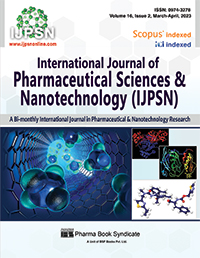New Trends in Therapy: From Natural Products to Nanomedicine
DOI:
https://doi.org/10.37285/ijpsn.2023.16.2.1Downloads
Metrics
Keywords:
Nanomedicine, drug delivery, Neurodegenerative Diseases, CancerDownloads
Published
How to Cite
Issue
Section
References
A. R. Bilia, V. Piazzini, C. Guccione et al., “Improving on nature: the role of nanomedicine in the development of clinical natural drugs,” Planta Medica, vol. 83, no. 5, pp. 366–381, 2017.
Jiang, Y., David, B., Tu, P., and Barbin, Y. (2010). Recent analytical approaches in quality control of traditional Chinese medicines--a review. Anal. Chim. Acta 657 (1), 9–18. doi:10.1016/j.aca.2009.10.024
Tu, Y. (2016). Artemisinin-A gift from traditional Chinese medicine to the world (Nobel lecture). Angew Chem. Int. Ed. 55 (35), 10210–10226. doi:10.1002/anie. 201601967
Zhang R, Liu F, Tian Y, Cao W and Wang R (2021) Editorial: Nanotechnology in Traditional Medicines and Natural Products. Front. Chem. 9:633419.
R. C. F. Cheung, T. B. Ng, J. H. Wong, Y. Chen, and W. Y. Chan, “Marine natural products with anti-inflammatory activity,” Applied Microbiology and Biotechnology, vol. 100, no. 4, pp. 1645–1666, 2016.
S. Sagar, M. Kaur, and K. P. Minneman, “Antiviral lead compounds from marine sponges,” Marine Drugs, vol. 8, no. 10, pp. 2619–2638, 2010.
D. J. Faulkner, “Marine natural products (1999),” Natural Product Reports, vol. 18, no. 1, pp. 1–49, 2001.
V. Agrahari, P. A. Burnouf, T. Burnouf, and V. Agrahari, “Nanoformulation properties, characterization, and behaviour in complex biological matrices: challenges and opportunities for brain-targeted drug delivery applications and enhanced translational potential,” Advanced Drug Delivery Reviews, vol. 148, pp. 146–180, 2019.
V. Agrahari, P. A. Burnouf, T. Burnouf, and V. Agrahari, “Nanoformulation properties, characterization, and behavior in complex biological matrices: challenges and opportunities for brain-targeted drug delivery applications and enhanced translational potential,” Advanced Drug Delivery Reviews, vol. 148, pp. 146–180, 2019.
Ma, Z., Fan, Y., Wu, Y., Kebebe, D., Zhang, B., Lu, P., et al. (2019). Traditional Chinese medicine-combination therapies utilizing nanotechnology-based targeted delivery systems: a new strategy for antitumor treatment. Int. J. Nanomed. 14, 2029–2053. doi:10.2147/IJN.S197889
N. Liu, H. Huang, S. Liu et al., “Calcium channel blocker verapamil accelerates gambogic acid-induced cytotoxicity _via_ enhancing proteasome inhibition and ROS generation,” Toxicology In Vitro, vol. 28, no. 3, pp. 419–425, 2014.
L. Ouyang, Y. Luo, M. Tian et al., “Plant natural products: from traditional compounds to new emerging drugs in cancer therapy,” Cell Proliferation, vol. 47, no. 6, pp. 506–515, 2014.
R. Yuan, Y. Hou, W. Sun et al., “Natural products to prevent drug resistance in cancer chemotherapy: a review,” Annals of the New York Academy of Sciences, vol. 1401, no. 1, pp. 19– 27, 2017.
G. J. Weiss, J. Chao, J. D. Neidhart et al., “First-in-human phase 1/2a trial of CRLX101, a cyclodextrin-containing polymer-camptothecin nanopharmaceutical in patients with advanced solid tumor malignancies,” Investigational New Drugs, vol. 31, no. 4, pp. 986–1000, 2013.
A. Samadder, S. Das, J. Das, and A. R. Khuda-Bukhsh, “Relative efficacies of insulin and poly (lactic-co-glycolic) acid encapsulated nano-insulin in modulating certain significant biomarkers in arsenic intoxicated L6 cells,” B, Biointerfaces, vol. 109, pp. 10–19, 2013.
A.Samadder,J.Das,S.Dasetal.,“Poly(lactic-co-glycolic)acid loaded nano-insulin has greater potentials of combating arsenic induced hyperglycemia in mice: some novel findings,” Toxicology and Applied Pharmacology, vol. 267, no. 1, pp. 57–73, 2013.
Y. Zhang, X. Yang, S. Wang, and S. Song, “Ginsenoside Rg3 prevents cognitive impairment by improving mitochondrial dysfunction in the rat model of Alzheimer's disease,” Journal of Agricultural and Food Chemistry, vol. 67, no. 36, pp. 10048–10058, 2019.
R. Aalinkeel, H. L. Kutscher, A. Singh et al., “Neuroprotective effects of a biodegradable poly(lactic-co-glycolic acid)-ginse- noside Rg3 nanoformulation: a potential nanotherapy for Alz- heimer's disease?,” Journal of Drug Targeting, vol. 26, no. 2, pp. 182–193, 2018.
M. J. Kim, S. U. Rehman, F. U. Amin, and M. O. Kim, “Enhanced neuroprotection of anthocyanin-loaded PEG-gold nanoparticles against Aβ1-42-induced neuroinflammation and neurodegeneration _via_ the NF-KB /JNK/GSK3 β signaling pathway,” Nanomedicine, vol. 13, no. 8, pp. 2533–2544, 2017.
Q. Y. Eng, P. V. Thanikachalam, and S. Ramamurthy, “Molecular understanding of epigallocatechin gallate (EGCG) in cardiovascular and metabolic diseases,” Journal of Ethnopharmacology, vol. 210, pp. 296–310, 2018.
B. J. Qian, C. C. Tian, X. H. Ling et al., “miRNA-150-5p asso- ciate with antihypertensive effect of epigallocatechin-3-gallate revealed by aorta miRNome analysis of spontaneously hyper- tensive rat,” Life Sciences, vol. 203, pp. 193–202, 2018.
A. Granja, I. Frias, A. R. Neves, M. Pinheiro, and S. Reis, “Therapeutic potential of epigallocatechin gallate nanodelivery systems,” BioMed Research International, vol. 2017, 2017.






